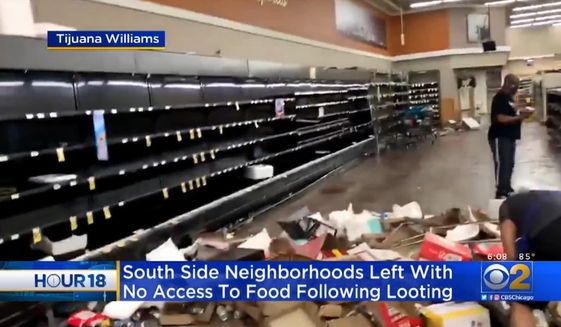
Article by Jazz Shaw in "HotAir":
As in many cities this week, the riots and destruction in Chicago overnight were considerably subdued compared to what we saw over the weekend. Perhaps that was because Kanye West showed up to march with the protesters and demand that the city’s public schools cancel final exams. Let’s hope the trend continues in that direction. But even as some business owners and residents begin trying to clean up the mess, the reality of what’s left of their neighborhoods was just starting to sink in.
Just as we saw with so many other cities, the looting and rioting were severe in Chicago, particularly in the already economically challenged South Side neighborhoods with primarily minority populations. Fires burned many structures and stores had their windows broken out and their contents looted. Residents have now realized that there are no longer any grocery stores in some neighborhoods. This area was already considered a “food desert” in terms of the availability of fresh food for home cooking, but now it’s a food wasteland. (CBS Chicago)
For neighbors, the Jewel-Osco on 75th is the grocery store. But no longer.
“It’s kind of a sad thing to think about,” said resident William Wright. “I take my grandma here every Sunday.”
On Sunday night, it was ravaged by looters, as you can see by the aftermath captured in video from the next day, leaving neighbors frustrated.
“It’s not what you do. It’s how do you do it,” Wright said. “What did we accomplish, aside from take our property value down and embarrass ourselves?”
Descriptions don’t really do the story justice. Check out this short video from the local CBS outlet and see what’s left of the only grocery store in the entire neighborhood.
Some of the stories told by local residents offer a personal perspective and make you realize precisely what these neighborhoods have lost. Plenty of people there don’t own their own cars and if you’ve ever tried to take a bus to go grocery shopping, you know what a nightmare that is. These are low-income neighborhoods and not everyone can afford to summon a taxi or an Uber (assuming you can even get one to come to make a pickup). Some people are already waking dozens of city blocks to purchase only as many groceries as they can carry by hand.
This is what came of the “protesting” that was, at least in these neighborhoods, little more than a thinly disguised excuse to loot every business, smash every window and engage in anarchy while literally setting the world on fire. And what did it get them? As one resident interviewed for this report sadly noted, they’ve managed to further drive down their property values and “embarrass themselves.”
And yet, even with all of this obvious evidence to point to, community organizers, elected officials and journalists don’t seem to be able to say the words when it comes to the need to stop the rioting, but they are happy to complain about anyone trying to maintain order. For example, there were some shop owners and residents in nearby communities trying to prevent the spread of the chaos to their neighborhoods. The press described reports of ” groups of mostly white men patrolling the streets of Bridgeport on Wednesday night.” And how did Chicago Mayor Lori Lightfoot respond to that story? By saying she “will not tolerate vigilantism.” We should note that there was not one instance of violence or anyone discharging weapons in that area.
I keep hearing people talking about how the tragic death of George Floyd is supposed to be a “teachable moment” when it comes to race relations and policing in our country, and perhaps it will prove to be so. But these events are also revealing precisely what happens when the opportunity to create chaos and mayhem presents itself and our law enforcement resources are overwhelmed.
Liberal activists might want to consider this story before they begin trying to “defund the police.”
https://hotair.com/archives/jazz-shaw/2020/06/05/chicago-riots-wipe-grocery-sources-minority-residents/
